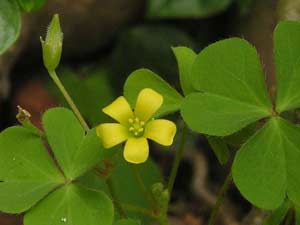Ground Sour Tamarind Leaves Chewed with Salt Treats Sore Throat. The Pulp of the Leaves Can Be Applied to Boils. Ground sour tamarind is also known as three-leaved sour tamarind, herbal tamarind, and sour herb.
 |
Ground Sour Tamarind with Yellow Flowers – Oxalis corniculata |
There are two types of ground sour tamarind. The yellow-flowered type (Oxalis corniculata) has small leaflets, while the pink-flowered type has larger leaflets.
Ground sour tamarind has a sour taste and a cooling property, which helps to clear heat, quench thirst, reduce coughing, and promote urination (the yellow-flowered type is more commonly used):
– To treat urinary issues: Use fresh ground sour tamarind and plantain (30g each), crush them, extract the juice, and add sugar to drink (as noted in “Southern Medicinal Efficacy”).
– To treat coughing: Combine yellow-flowered ground sour tamarind (20g), newly sprouted bamboo shoots (20g), white inner bark of mulberry roots (10g, processed with honey and lightly roasted), and ginger (8g). Crush together, add a little sugar or honey, steam, and consume.
You can use the leaves of yellow-flowered ground sour tamarind alone; wash them thoroughly, chew with salt, and gradually swallow the juice to treat a sore throat. For external use, the leaves can be crushed, heated, and applied to swellings and boils.
The stems and leaves of ground sour tamarind contain oxalic acid, especially potassium oxalate in high amounts, which is why the plant has a sour taste. During summer, many people often pick ground sour tamarind leaves to boil and eat with water spinach instead of lime, sour plums, or tamarind leaves. The broth from boiling the leaves has a sour taste and refreshing aroma. Occasionally consuming it is fine, but daily use can lead to the formation of oxalate stones in the bladder, resulting in stone disease. Those who have suffered from this condition should avoid ground sour tamarind leaves, as oxalate can increase stone formation.
Furthermore, it is advisable not to consume ground sour tamarind leaves in excessive amounts, as oxalate can be toxic at doses of 20 – 30g.
Pharmacist ĐỖ HUY BÍCH


















































